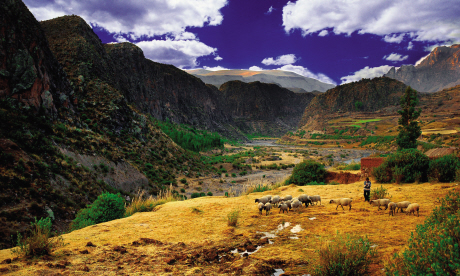
Tom Shearman, from Latin American tour specialist Andean Trails, explains what you need to know before trekking independently in the Andes
The fitter you are before the trek starts, the more you will enjoy it. Your time is spent enjoying the fantastic scenery rather than thinking ‘if I can just make it to lunch time’ and ‘my legs feel like they’ve been run over by a bus’.
Walking is the best training, particularly up and down hills and carrying a backpack. Other core strength activities like swimming and yoga are good, as well as running and going up and down (many) stairs.
Get good quality trekking boots and socks. Break them in before you go so that they are comfortable, as you don’t want to suffer blisters in remote areas and with the only exit available on foot. Wearing one thick pair of socks and a thin inner pair can help reduce risk of blisters too. A small container of baby talc is perfect to refresh the feet (and soul) after a hard day’s walking – remove socks, apply liberally, and tramp once more.
A pair of trainers and/or sandals for camp can be a real treat too, depending on how much weight you/mules/porters are prepared to carry.
Many of South America’s best treks involve being at altitude for extended periods of time. Acclimatising properly before the trek is as important as being fit for the trek. Fitness does not equal acclimatised. Being at altitude, especially in the tropics, is usually a pleasure as it isn’t so hot, there are few insects and the air is clear.
Rest for a few hours on arrival at altitude and take it easy for the first couple of days. Note that you may feel fine on arrival and tempted to exert yourself as normal. Don’t be fooled: you might be benefiting from oxygen brought in your blood from sea level.
Drink plenty of water to avoid dehydration (altitude is a diuretic). Coca tea (mate de coca) helps alleviate symptoms. Eat light meals, with high carbohydrate and low fat and protein content. Dine early, allowing digestion time pre-sleep.
Avoid or minimise consumption of cigarettes and alcohol. Avoid sleeping pills.
The Andes offer extreme differences in temperature – warm days with strong sunshine and very cold nights.
While remembering the maxim ‘Twice as much money, half as many clothes’ while packing, you need to make sure you get good quality, comfortable and versatile kit from home – it’s hard to source and very expensive to buy in South America.
The most important things to take are the basics – boots, sleeping bag, thermarest (if you have space), ruck sack, waterproof jacket and trousers, and, if you have the budget, a cosy down jacket for campsites.
Things like sunhats, socks, pants, woolly hats etc can be bought locally if you need to keep weight down, although the quality is not the same.
I always take some chocolate or favourite snacks from home too – can’t beat a bit of 80% dark chocolate, which is almost always better than the local sweets.
Locals have a great tradition of welcoming tourists – greet people in a friendly fashion, dress conservatively (ie men keep their shirts on) and speak some words and you will most likely have no problems.
You may be offered accommodation, and it’s OK to refuse, but don’t then go and set your tent up just over the field. Some villagers may make no contact at all – leave them to come to you, if they wish, and do not approach their houses.
People are usually both friendly and shy, polite and curious. They may well want to talk and having some Spanish or Quechua words is the secret. Tell people where you are from, where you are going, but avoid giving out sweets and pens and gifts.
If you do accept accommodation and food, share some of your food with them – this is expected, much more so than presents – and do offer to pay too. And if it is clear you are not welcome, or you are asked to leave, please do so, as it is their land and they will have their reasons.
If you are hiking into really remote areas, try to find out about the people and their customs before you go. A local guide will do much to prevent misunderstandings as well as showing you the way.
Coca has been used by the Andean people for more than 2,000 years in social activities and rituals, and the leaves are seen as a sacred gift from Pachamama (Mother Earth).
Sharing coca leaves with a stranger is the equivalent of shaking hands.